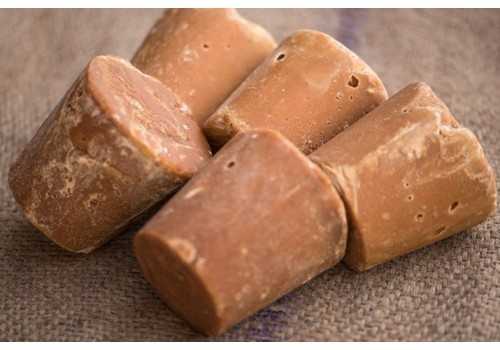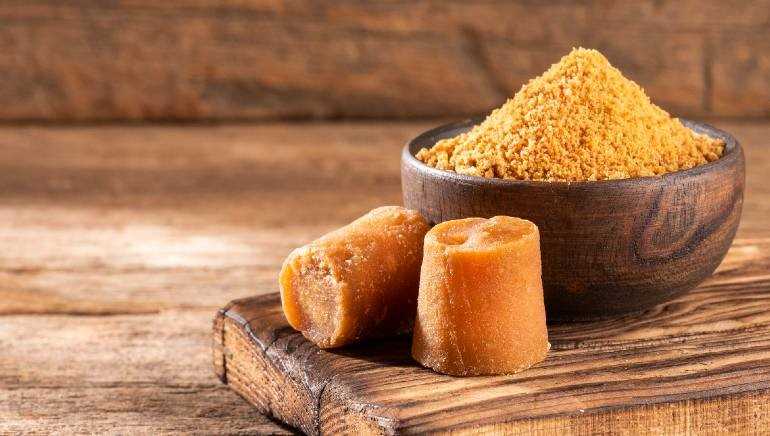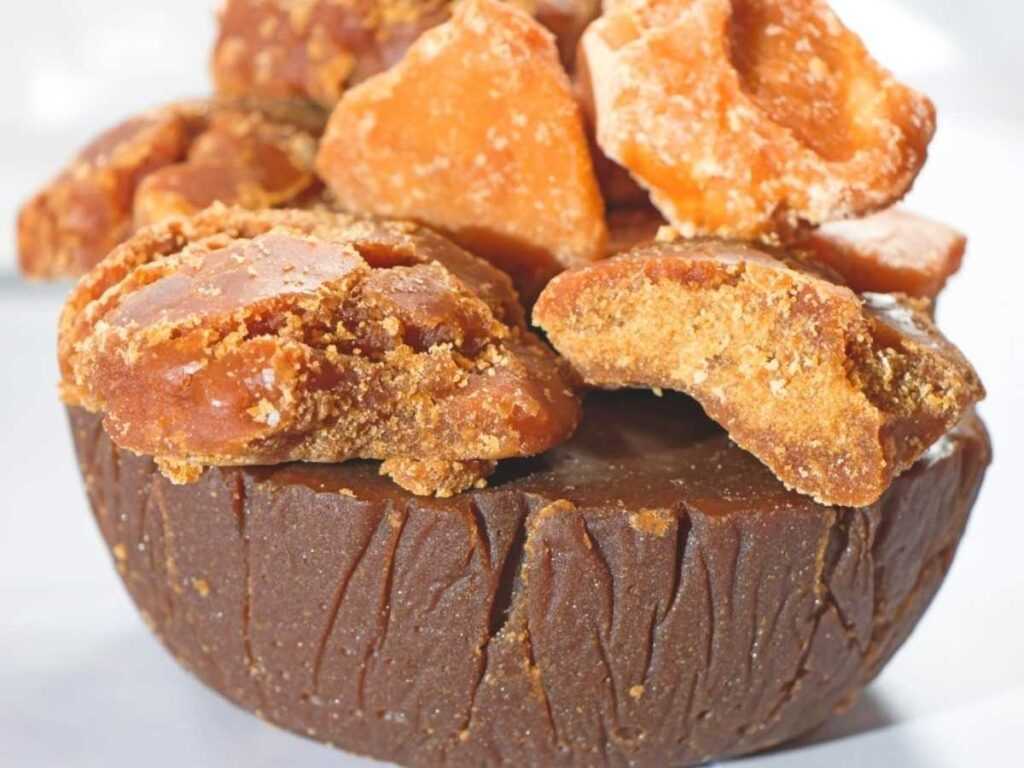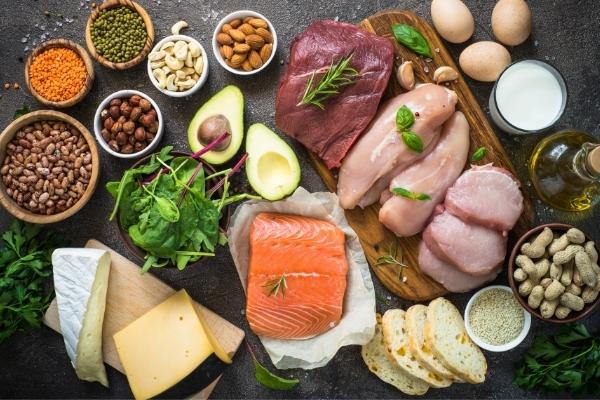India is the largest consumer and the second largest producer of sugar in the world. Sugar industry is the second largest organized sector industry in the country. Among the sugar yielding crops like sugarcane, sugar beet, palms and sorghum, sugarcane is the most important.

Sugarcane crop is cultivated for the production of sugar, but the processing of sugarcane yields various valuable products such as bagasse, brown sugar, molasses, syrup, and jaggery, along with sugar (table sugar). Sugar is of considerable cultural relevance in India; nutritionally it provides only “empty” calories (1g of sugar gives 4 kcal). It lacks the natural minerals which are present in the beet root or sugarcane.
Jaggery (also called as Gur in India, Desi in Pakistan, Panela in Mexico and South America, Jaggery in Burma & African countries, Hakuru in Sri Lanka, and Naam Taan Oi in Thailand) is a traditional Indian sweeteners, which is produced in addition to sugar from sugarcane.
In the early 1930’s, nearly 2/3rd of sugarcane production was utilized for production of these alternate sweeteners, like jaggery. With the introduction of sugar mills and their multiple growth, better standard of living and higher per capita income, the sweetener demand has shifted to white sugar, which contains purely sucrose (99.7%).
JAGGERY PRODUCTION
Jaggery is available in the market mainly in three forms namely solid jaggery, liquid jaggery and granular jaggery. Of the total production of jaggery in India, approximately 80% of the jaggery is prepared in solid form and the remaining 20% is prepared in liquid as well as granular form.
Sugarcane juice is an opaque liquid and varies in colour from grey dark green to light yellow depending upon the colour of cane. In addition to various nutritional constituents, it also contain mud, wax and several other soluble and in soluble impurities. To maintain proper quality in jaggery, all these soluble and in soluble undesirable fractions should be removed. However, the manufacturing process depends on the ultimate form to be produced. Also, the minute detail of the process varies widely from state to state, in the state from one district to another, and in some cases within a district also.
Jaggery manufacturing process consists of the following unit operations, i.e., juice extraction, juice clarification, juice concentration by boiling, cooling of concentrated juice followed by moulding and storage.

Extraction of juice by crushing sugarcane is the first step in jaggery manufacture. Boiling of sugarcane juice is the second important step, where the juice is clarified and impurities are removed. The juice is boiled in shallow iron pans with continuous stirring. Removal of impurities is done mainly by using lime (calcium hydroxide). Calcium acts complexing agent and form scum, which is time to time removed during boiling. Addition of lime also improves the consistency of jaggery by increased crystallization of sucrose, but at the same time it darkens the colour if added in excess.
Boiling is continued for 2–2.5hrs till the juice attains a temperature of 118deg C. End point is judged by taking a small quantity of hot syrup from the pan, cooling it in cold water taken in a container, and finally shaping with finger. If shape is formed it means that the pan can be removed from the furnace.
Properly concentrated juice is taken out of fire. Hot syrup is worked out for some time and then let to solidify. For solidification, the contents are transferred to a wooden/aluminium moulds or earthenware pots. This serves both the purpose of cooling and moulding. From 100 kg of sugarcane, 10 kg of jaggery is made.
Jaggery deteriorates fast and become watery within 3 or 4 months because of presence of moisture, invert sugar and its hygroscopic nature. The hygroscopicity arises from non-sucrose constituents like glucose, fructose, protein, etc. For good keeping quality, moisture content of jaggery should not exceed 6% and be kept at a relative humidity of 43–61%. It is very difficult to store jaggery during monsoon, especially in coastal areas of high rainfall and humidity.
PERCEIVED BENEFITS OF JAGGERY
Jaggery, a product of sugarcane, is rich in important minerals (calcium: 40–100mg, magnesium: 70–90mg, potassium: 1056mg, phosphorus: 20–90mg, sodium: 19–30mg, iron: 10–13mg, manganese: 0.2–0.5mg, zinc: 0.2–0.4mg, copper: 0.1–0.9mg, and chloride: 5.3mg per 100g of jaggery), vitamins (vitamin A: 3.8mg, vitamin B1: 0.01mg, vitamin B2: 0.06mg, vitamin B5: 0.01mg, vitamin B6: 0.01mg, vitamin C: 7.00mg, vitamin D2: 6.50mg, vitamin E: 111.30mg, and vitamin PP: 7.00mg), and protein: 280mg per 100g of jaggery, which can be made available to the masses to mitigate the problems of malnutrition and under nutrition.

Jaggery is often called the medicinal sugar and possesses nutritive properties of high order. Ancient medical scripture, Sushrata Samhita state how it purifies the blood, prevents rheumatic afflictions and bile disorders. Jaggery is very rich in iron and prevents anaemia. Jaggery supplements the requirement of iron and calcium in women and children and also increases vitality in men and help in digestion.
Gud or jaggery has been used in the Ayurvedic Medicine for 3000 years. Different types of gudas are explained in different classical texts such as Purana guda (Preserved jaggery), Naveena guda (Freshly prepared jaggery), Dauda guda (Impure jaggery), Adauda guda (Pure jaggery). Each type of gud has been shown to have its own unique properties, and special emphasis has been laid on preserved guda, with 3-4yr old guda said to be among the best.
Jaggery is very good as a cleansing agent. It cleans lungs, stomach, intestines, oesophagus, and respiratory tracts. Those who face dust in their day-to-day life are highly recommended to take a daily dose of jaggery. This can keep them safe from asthma, cough and cold, congestion in chest, etc. Gur is known to produce heat and give instant energy to a human body. Gur is supplied to the workers for in order to protect them from dust allergies.
Sugarcane is said to contain several amazing beneficial compounds like chlorogenic acid, cinnamic acid, a number of phenolic compounds, flavonoids. Phenols help in the natural defence of plants against pests and diseases.
It activates digestive enzymes in our body and helps in digestion. That’s why Ayurveda recommends people to eat jaggery after dinner.
REAL BENEFITS OF JAGGERY
We need to understand that nutritional facts have to be based on some scientific research or evidence, or else it has to be taken along with a pinch of salt.
When it comes to jaggery, no doubts it’s a healthier alternative for refined sugar. But it is still the same in terms of calories. So, you can surely have it daily and even try and replace it with refined sugar, but the quantity has to be kept in check. Just because it has some extra minerals, it doesn’t by anyways means, an uncontrolled use of it. The amount has to be controlled, as ultimately it’s a sweet.

Surely, the best part is its iron rich content, along with other minerals, so it can be used to replace white refined sugar in multiple places. It also has a great mention in Ayurveda and is still being used medicinally, but again, nowhere in the Ayurveda it is written, that you can use it to your heart’s content. Control the quantity please.
In a lot of places, I read that jaggery is a great cleansing agent and it helps cleans lungs, stomach, intestines, oesophagus, and respiratory tracts. But I couldn’t find any evidence behind such claims. If you have a respiratory disorder like asthma, bronchitis etc. eating jaggery won’t cure anything.
In traditional Indian household or in other traditional medicinal systems, jaggery is given along with a number of herbs like ginger, tulsi, pepper etc. These combinations in unison help because of they possess lot of anti-inflammatory and antioxidant properties. Jaggery does not have any Broncho dilating properties or it does not increase the airflow to the lungs.
Similarly, having minerals is great, but it doesn’t mean a cure for diseases. If you are anaemic, jaggery can be a good replacement for sugar because of presence of iron in it. But the amount of iron present is quite less. For e.g. the amount of iron in 100gm of jaggery is app. 11mg, which is equivalent to app. 60% of RDI. But 100gm jaggery means, almost half a cup full. What about the calories coming in with that amount of jaggery?
A tablespoon (20 grams) contains 2.2mg of iron, or about 12% of the RDI. A teaspoon (7 grams) contains 0.77mg of iron, or about 4% of the RDI. Foods like organ meats, spinach, tofu, dark chocolate, pumpkin seeds etc. are much richer sources of iron.
The good quality Gur contain more than 70% sucrose, less than 10% of glucose and fructose and 5% minerals, 3% moisture, and accumulate large amount of ferrous (iron) during its preparation in iron vessel. Jaggery is far complex than sugar, as it is made up of longer chains of sucrose. Hence, it is digested slower than sugar and releases energy slowly and not spontaneously. But this does not certify it fit for consumption by diabetics, because ultimately it is sugar.
On the other hand refined sugar is virtually >99% sucrose, and no micronutrients, which makes it completely empty in terms of nutrition. In that sense, of course jaggery a great replacement for sugar.
USES OF JAGGERY
In many parts of India, there is a tradition of serving a glass of water with Gur to welcome the guests. Gur is also used as a cattle feed, in distillery, medicine manufacturing unit, ayurvedic medicines, ayurvedic sura and ayurvedic health tonics. Recently Gur has also found a place in confectionary items. A usage of Gur is also seen in leather and tobacco industries. Besides, in cement industries and coalmines, Gur is supplied to the workers for in order to protect them from dust allergies. And at the time of natural calamities, the district administration purchases Gur and distributes it to the victims for various health benefits. In Ayurvedic way of medicine, it is used as medicine, blood purifier and base material for syrups.

Mosst vegetable dishes, curries, and dals, and many desserts contain it. Jaggery is especially used during Makar Sankranti for making a dessert called tilgul.
In Gujarat, a similar preparation known called tal na ladu or tal sankli is made.
In rural Maharashtra and Karnataka, water and a piece of jaggery are given to a person arriving home from working under a hot sun. In Indian culture during the New Year feast, jaggery-based sweets are made.
In Karnataka on Ugadi festival day (Karnataka New Year), before starting the feast Neem leaves and jaggery are consumed together symbolising life; neem which is bitter in taste symbolizes the hurdles in one’s life, and jaggery which is sweet in taste symbolizes happiness in life.
It is an ingredient of many sweet delicacies, such as gur ke chawal / chol (“jaggery rice”), a traditional Rajasthani or Punjabi dish.
A well-known Maharashtrian recipe, puran poli, uses it as a sweetener apart from sugar. Jaggery is considered an easily available sweet which is shared on any good occasion.
In Andhra Pradesh and Tamil Nadu it is used for sweets such as chakkara pongal and milk pongal (prepared with rice, milk, jaggery).
A sweet liquid called “Paanakam”, made of water, jaggery and peppercorns is prepared as the favourite offering to Lord Rama during Ram Navami festival. In Kerala, it is considered auspicious and is widely used in cooking. It is a vital ingredient in many varieties of payasam, a sweet dish.
In Tamil Nadu, jaggery is used exclusively as a sweetener. It is used in a dish called chakkarai pongal. It is prepared during the festival of Pongal (Thai Pongal),
In Odia cuisine, cakes or pithas contain jaggery.
In Bengali cuisine, it is commonly used in making sweet dishes, some of which mix jaggery with milk and coconut. Popular sweet dishes such as laḍḍu/laṛu mix it with coconut shreds.
Some of the popular sweet dishes of Assam such as til-pitha (made of rice powder, sesame and jaggery), other rice-based pitha, and payas are made of jaggery. In some villages of Assam, people drink salty red tea with a cube of gurd (jaggery), which is popularly called cheleka-chah (licking tea).
Jaggery is also used in sweets like sesame laddu and chikki



